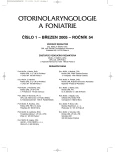-
Medical journals
- Career
Bleeding after Tonsillectomy
Authors: L. Školoudík; Z. Dufek; J. Vokurka; P. Čelakovský
Authors‘ workplace: Klinika ušní, nosní, krční LF UK a FN, Hradec Králové přednosta doc. MUDr. J. Vokurka, CSc.
Published in: Otorinolaryngol Foniatr, 54, 2005, No. 1, pp. 42-46.
Category: Original Article
Overview
Summary:
The authors performed a retrospective analysis of documentation for patient who had undergone tonsillectomy at the Ear, Nose and Cervix Clinic in Hradec Králové during 1992–2001. The cohort consisted of 1492 patients, 841 of them being women and 651 men. The mean age of the patients was 22 years, median 19 years.
All operations in the period of observation were performed by the classical extracapsular technique with stopping preoperation bleeding by bipolar electrocoagulation or ligature. The mean period of hospitalization was five days.
A significant bleeding, i.e. bleeding which required a local treatment, was detected in 49 (3.3%) patients, early bleeding up to 24 hours being observed in 20 (1.3%) patients and late bleeding in 29 (1.9%) patients. A minute bleeding which did not require medical care was detected in other 140 patients, early bleeding being inn 93 (6.2%) and late bleeding in 47 (3.2%) patients.The authors followed the influence of the following factors on bleeding after tonsillectomy:
age of the patient, sex, effect of surgical technique, surgeon, peritonsillar abscess in anamnesis, left tonsillar tissue in the bed, effect of postoperation acute infection and the effect of the time period of the year.
The study demonstrated a statistically significantly more frequent peroperation bleeding in adult patients as compared with children younger than 15 years (p=0.0005), more frequent early bleeding in patients operated on in local anesthesia (p=0.0005), more frequent early bleeding with the use of a loop for incarceration of the lower pole of tonsil (0.018), more frequent late bleeding in patients operated on peritonsillar abscess “a froid” (0.003) and more frequent bleeding when a residuum of tonsillar tissue was left (p=0.004). Effects of othger observed factors on postoperation bleeding were statistically insignificant. The processing of the risk factors may be used in decision making concerning the duration of hospitalization of patients after tonsillectomy.Key words:
tonsillectomy, bleeding, operation technique.
Labels
Audiology Paediatric ENT ENT (Otorhinolaryngology)
Article was published inOtorhinolaryngology and Phoniatrics

2005 Issue 1-
All articles in this issue
- Classification of Developmental Language Disorders
- Central Hearing Loss in Children with Developmental Dysphasia
- Observation and Therapy of Acute Postoperation Pain in Otolaryngology
- Bleeding after Tonsillectomy
- Testing Olfaction Merkers by Means of Perfumed
- Autoinflation in Curing Up the Middle Ear Inflammation
- Relapsing Middle Cervical Cyst and Atypical Position of Hyoid Bone
- Peroperation Electromyographic Monitoring in Cranial Base Surgery
- Present Classification of Laser Cordectomy
- The Results of Therapy of Early Glottic Carcinoma at the Clinic of Otolaryngology, Head and Heck Surgery, St. Anna University Hospital during the Fifteen Year Period
- Fistulas and Cysts from the First Branchial Grove
- Otorhinolaryngology and Phoniatrics
- Journal archive
- Current issue
- Online only
- About the journal
Most read in this issue- Relapsing Middle Cervical Cyst and Atypical Position of Hyoid Bone
- Central Hearing Loss in Children with Developmental Dysphasia
- Testing Olfaction Merkers by Means of Perfumed
- Present Classification of Laser Cordectomy
Login#ADS_BOTTOM_SCRIPTS#Forgotten passwordEnter the email address that you registered with. We will send you instructions on how to set a new password.
- Career

